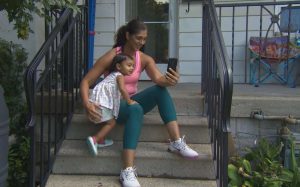Pandemic threatens to wipe out decades of progress for working mothers

Charlotte Schwartz has four children under the age of 10, one with special needs. She also has a full-time career as a legal clerk at a busy family law practice in Toronto, and since the pandemic forced people into their homes in March, she’s been doing both her jobs around the clock with little reprieve.
“I’ve started to shift my day,” said Schwartz, 37. “So, I do a bunch of stuff pretty early in the morning, a bunch of stuff late at night, but it’s very … exhausting.”
Schwartz is one of millions of women who have been juggling full workloads and full child-care responsibilities during the pandemic, and the strain of the situation is starting to show.
While one might think, in 2020, that strain would fall equally on the shoulders of all parents, that’s not what the data shows. During COVID-19, women’s participation in the Canadian workforce has fallen to a level not seen in decades, and with uncertain school plans and few options for child care, some women are not returning to work.
“Some of the women who were laid off are actually not looking anymore, that’s deeply concerning,” said Jennifer Reynolds, CEO of Toronto Financial International, a firm aimed at boosting investment in the city and encouraging women’s participation in the workforce.
“If we don’t get women back to work in the types of numbers we saw before … we won’t get the economic growth that we really need.”

Pandemic ‘shecession’
A report last month from RBC Economics called the hit on women’s employment “unprecedented,” with 1.5 million women in Canada losing their jobs in the first two months of the pandemic. In April, women’s participation in the Canadian workforce — or the share of the working-age population that is working or looking for work — fell to 55 per cent, a level last seen in May 1986.
In prior recessions, the report said, the unemployment rate for men was higher than women, but not this time.
One of the factors at play here, says Reynolds, is that women are more highly represented in service jobs, such as work in restaurants, hotels and retail. Those were the sectors hardest hit by the pandemic shutdowns, with workers only returning gradually now.
Reena Parekh, a personal trainer in Toronto, found herself with virtually no employment when gyms shut down in March. She was quick to move client consultations online, but the impact on her income was significant.
“I feel like I’m starting all over again after building up a business for the last few years,” she said.
“I’ve had to … really come to terms with how I’m going to move forward.”
Parekh, 36, also has young children at home: a five-year-old who was in kindergarten before the pandemic and an 18-month-old who was supposed to enter daycare this year. Now, she’s juggling caring for them while continuing to work. It’s a situation experts say is contributing to the decreasing number of women working again or looking for work.

“Certainly, child care is factoring into that,” said Reynolds. “If we don’t have child care, if we don’t have children in schools, that work does fall predominantly, in most cases, to women.
“And, so those women don’t really have a choice, particularly if they work outside of the home.”
Losing ground
The trend of women bearing the brunt of pandemic child care while trying to continue working has been the topic of countless articles. The New York Times recently referred to the phenomenon as a “shecession.”
Parekh definitely identifies with that.
“Yes, I’ve made a decision not to go back [to the gym] until at least the end of the year,” she said. “It’s hard because I feel like I’m holding myself back in some ways. I’ve definitely taken an income cut, which makes it even harder in certain ways to live day to day.”

Schwartz admitted that on her hardest days, she’s also considered taking a leave from her job, but is still desperately resisting the option.
“It would be devastating for me right now to take a step back in my career. I would miss a lot,” she said.
“I didn’t take maternity leave with any of the kids. I was terrified of what would happen being out of the workforce for a year…. So, it’s very stressful.”
Lower pay at work, 2nd shift at home
The wage gap is another reason that in heterosexual partnerships, it’s the mothers — more than fathers — that have stepped out of the workforce in greater numbers. Parekh says that was a factor in her family.
“When we look at a household with two incomes, and the man is making more, the other person — it almost doesn’t make sense for that person not to step back,” she said.
In Parekh’s case, business at her husband’s take-out samosa shop, East of York, is booming so the decision seemed obvious.
Statistics Canada has long documented the wage gap in Canada. According to its 2018 data women, on average, earn 87 cents for every dollar earned by men.
The reason for that, said Reynolds, is in part that women tend to be in professions that earn less money, but there is also “outright discrimination for women working in the same roles” and being paid less.
“As long as we have that gender wage gap, women are not going to have economic equality.”

Then there’s the unpaid labour, at home — the so-called second shift of housework and child care that many women do on top of paid work. Schwartz admits that in her home, and many of her friends’ homes, the roles have reverted to more traditional ones since the onset of COVID-19.
“It’s just very typical, and that’s why it’s disappointing, you know?” said Schwartz.
“I don’t see groups popping up on Facebook of men supporting other men because of men losing their jobs over the disproportionate amount of housework and child care that they have to provide.
“I don’t see that happening, because it’s not.”
Parekh agrees.
“It feels like we’re falling right back into an old pattern,” she said. It’s devastating in many ways, right? We fought for so long … and yet it feels like we haven’t made any progress at all,” she said.
“The reality is that [in] most households [with] two working parents, that responsibility needs to be better spread out.”
Economic fallout
Reynolds worries the shift in responsibilities could become permanent as women may find it harder to re-enter the workforce if they decide to later.
“If you take a few years out, there’s no doubt about it, it’s hard to go back,” she said.
It’s a possibility everyone should be concerned about, said Reynolds.
“This could have very, very long term impacts on women and on the broader economy,” she said.
“People don’t always identify that women’s work and women participating in the labour force is actually a huge growth generator for the economy.”
The RBC report also warns of “significant economic consequences” if women’s participation rate doesn’t return to pre-COVID levels.
In the meantime, Schwartz and Parekh, and mothers like them across the country, are just trying to make it through the day. Some days are easier than others.
“It’s really hard because when I was going into the office, I could shut out everything and get my work done,” she said. “Now, anxiety is high because you’re still trying to have this career that, in my case, I’ve been building for 18 years, but then all these additional tasks fall to you.”
Parekh, who has continued to do virtual consults with clients, always warning them her kids are in the background, has also felt the toll of juggling her work and family responsibilities. And yet, she is motivated to keep going — in part to be a mentor for her son and daughter .
“My kids are young, but they’re still watching,” she said.
“I know one day, we’re going to look back on this and talk about the time we were in isolation, but mommy kept working, mommy kept going and doing what she needed to do.
“So, I applaud all the women who are working two jobs right now or more and supporting their families. It’s not easy on anyone.”
CBC








Redes Sociais - Comentários